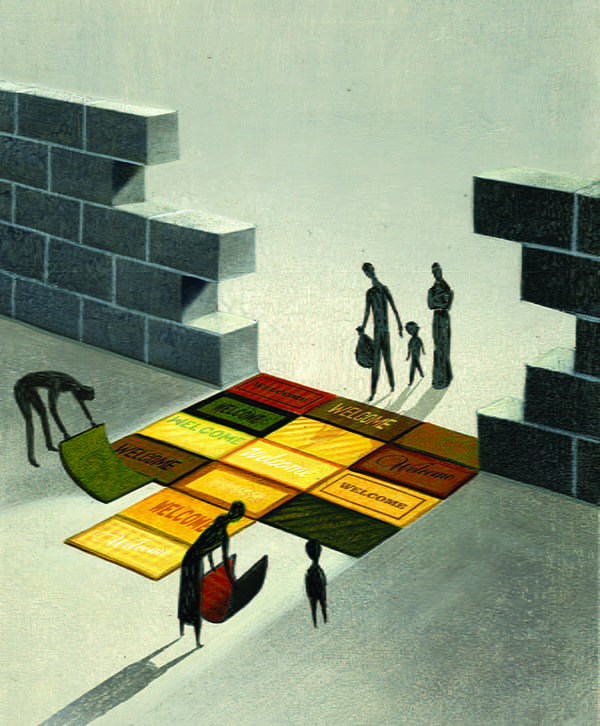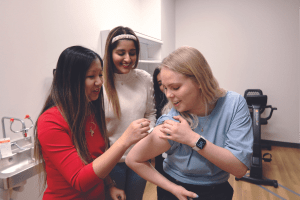Breaking Down BARRIERS

CONHI’s Public Health program helps uplift vulnerable communities.
Whether examining disease outbreaks, preventing illnesses, developing policies, or analyzing disparities, public health professionals are focused on protecting and improving the health of people and their communities. It is an essential mission, with far-reaching effects that can be felt across the globe. Through studying different groups, from entire city populations to specific segments of people, public health is highly interdisciplinary, encompassing an expansive range of subjects.
This significant and comprehensive objective of improving public health is what motivates faculty, staff, and students in UTA’s Public Health program. Established in 2018 within the College of Nursing and Health Innovation (CONHI) and housed within the Department of Kinesiology, it is one of the College’s newest programs. With both undergraduate and graduate offerings, it attracts a wide variety of students and faculty who are interested in making a difference in health and the human condition.
“The public health program has been a fantastic addition to our College,” says Paul Fadel, associate dean for research in CONHI. “It’s also very timely, with the COVID-19 pandemic and increased need for education and dissemination of accurate health information.”
Even though the program is young, it is already having a significant impact thanks to diverse faculty who are creating new knowledge through their research.
“Their research represents many distinct aspects of public health research,” says David Keller, associate dean, chair, and professor of kinesiology. “We have faculty doing fundamental, almost clinical-trial types of research, we have faculty doing epidemiological types of studies, we have faculty doing work with big data, and we have everything in between.”
IMPROVING OUTCOMES
“Our faculty has truly diverse expertise, which lends itself to lots of collaboration,” says Assistant Professor Kyrah Brown. “We are small but mighty.”
Dr. Brown serves as the director of the Maternal and Child Health (MCH) Equity Lab. Her lab examines the social and structural determinants of maternal health and outcomes. By analyzing factors like structural and gendered racism, she seeks to understand how and why Black women are disproportionately impacted by maternal and infant mortality compared to women of other racial and ethnic groups.
“We’re interested in a person’s health prior to pregnancy and trying to understand the factors that put people at risk for cardiometabolic issues and how that ultimately impacts their birth outcomes,” says Brown. “Recognizing when we are talking about maternal and infant health disparities, we can’t continue to focus only on the individual level. There are so many social and systems-level issues that drive these disparities. We must recognize that systems and forces such as structural racism are one of the main drivers of racial disparities in maternal and reproductive health.”
The MCH lab also recently completed a study exploring knowledge, attitudes, and barriers related to COVID-19 in pregnant and postpartum women.
“We launched in the early months of the pandemic when we noticed there was not a lot of tailored messaging for the perinatal population,” Brown says. “One main thing we discovered is that there weren’t many racial differences in COVID 19 knowledge, which shows the overall lack of knowledge with pregnant and postpartum women during that time.”
HEALTH IN ACTION
In another research project examining the effects of racial disparities on health, the Physical Activity and Wearable Sensors (PAWS) Lab is working with vulnerable populations to gain insight into people’s daily habits regarding physical activity and exercise through wearable trackers and sensors.
Led by Assistant Professor Yue Liao, the PAWS researchers are utilizing both research-grade monitors along with commercially available devices, like Fitbits, when working with target demographics, including cancer survivors and Black and Hispanic women with obesity.
“We know that racial minorities, particularly Hispanic and Black women, are the groups with the highest obesity rates and are less likely to meet the recommended levels of physical activity when compared to other racial groups,” says Dr. Liao. “That puts them at higher risk for developing chronic diseases, such as diabetes, heart disease, and certain types of cancer.”
Liao continues to study these discrepancies, harnessing information at both neighborhood and personal levels.
“Everybody can get a Fitbit or other tracker,” she says. “I want to find out how we can better utilize these commercially available wearables so that it is not just a watch that people are wearing, it’s a tool to help improve their lifestyle choices.”
ENVIRONMENTAL FACTORS
In a similar vein, the Social Determinants of Health (SDOH) Lab is currently exploring the framework by which residential environments can impact health and health disparities.
By examining a broad assortment of various neighborhood attributes, such as walkability, Assistant Professor Yeonwoo Kim and her SDOH team seek to determine the connections between where people live and their health outcomes. They are specifically looking at the influence that physical and social neighborhood environments may have on cardiovascular health and childhood obesity. Ultimately, SDOH seeks to provide empirical evidence that links these social determinants to a wide range of health inequalities.
neighborhood environments may have on cardiovascular health and childhood obesity. Ultimately, SDOH seeks to provide empirical evidence that links these social determinants to a wide range of health inequalities.
“If this research does find neighborhood factors like racial segregation and income impact cardiovascular disease in minority and low-income people, then we can begin to approach those issues from a local policies perspective,” says Dr. Kim. “Then, hopefully, we can reduce cardiovascular disease for the entire community.”
In addition to being influenced by residential environments, cardiovascular health and heart disease are also significantly affected by tobacco use. It’s an issue that Assistant Professor Ziyad Ben Taleb is closely examining in his work as director of the Nicotine and Tobacco Research Lab.
“My focus is on the importance of understanding the patterns and consequences of tobacco use, along with its impact on public health,” says Dr. Ben Taleb. “Much of my research has tobacco regulatory science playing into it. For the FDA to introduce tobacco regulations that make sense and that work, they need scientific evidence. A lot of my studies aim to provide evidence to guide policy for tobacco products.”
Recently his lab received a grant from the National Institutes of Health to begin examining the effects of hookahs on health, addiction, and behaviors. Ben Taleb understands the many benefits of collaborating with others to address this leading cause of mortality.
“It’s wonderful to collaborate with other faculty,” he says. “They genuinely want to see how they can add value to your research, as well as how you can add value to theirs.”
DATA-DRIVEN
Behind nearly every public health issue is a mountain of data that has been compiled over time, and that is where Tiffany Kindratt and the Health Survey Research (HSR) Lab are focusing their efforts.
Established in 2019, HSR lab conducts epidemiologic research studies focused on predictive factors and how they influence behaviors like physical activity, disease diagnosis, and the use of health services like cancer screenings. To do so, Dr. Kindratt is examining large national data sets through publicly available data and linking data sets in Dallas.
Specifically looking at the Arab/Middle Eastern and North African (MENA) American population, Kindratt is one of the first researchers to use Medical Expenditure Panel Survey data to examine patient experiences and the prevalence of diseases, including dementia and diabetes, among Arab/MENA Americans.
“One study we have is looking at cognitive limitations as a predictor for Alzheimer’s disease, because there is some evidence starting to suggest that Arab Americans do have a higher risk than other racial and ethnic groups,” she says. “There is an effort to find ways to uncover different health disparities among this group, while also trying to advocate for a policy change to give them their own category within the U.S. Census and including them in all minimum reporting guidelines within the U.S.”
STUDENT INVOLVEMENT
While its research initiatives are centered on protecting and championing populations throughout the world, UTA’s Public Health program also seeks to create a learning environment that inspires ways to improve health and well-being.
“The students are central to our work,” says Ben Taleb. “We all think about the best interest of the students and how we can help them develop knowledge, perform well, and have the resources available for them to advance as researchers. It’s extremely rewarding to see them growing and starting to produce their own ideas and projects.”
 Kindratt, who has developed a course related to research methods for graduate students, agrees. “We’re trying to equip students with the ability to do research in the future, which includes sharing the available resources that the department generously provides us.”
Kindratt, who has developed a course related to research methods for graduate students, agrees. “We’re trying to equip students with the ability to do research in the future, which includes sharing the available resources that the department generously provides us.”
Bringing a new wave of distinctive voices to the public health sector will help to not only continue the conversation, but also allow the field to keep evolving as more evidence and challenges appear.
“There’s research in every field, of course, but public health is one that affects all of us and can directly make a difference,” says Dr. Keller. “With public health, we have such a diverse and collaborative faculty group that can impact so many aspects of human health. As our faculty and this program grow, it will hopefully not only affect our students, but also allow people to recognize the direct benefit of the work they are doing.”
Contents
Rounds
1971-1980
Continuing Education Flourishes
Lectures Keep Futures In Focus
1981-1990
1991-2000
Facilitating Degree Attainment
Groundbreaking Student Research
2000-2010
2010-2022
Giving: Dream Makers Celebrates 20 Years
